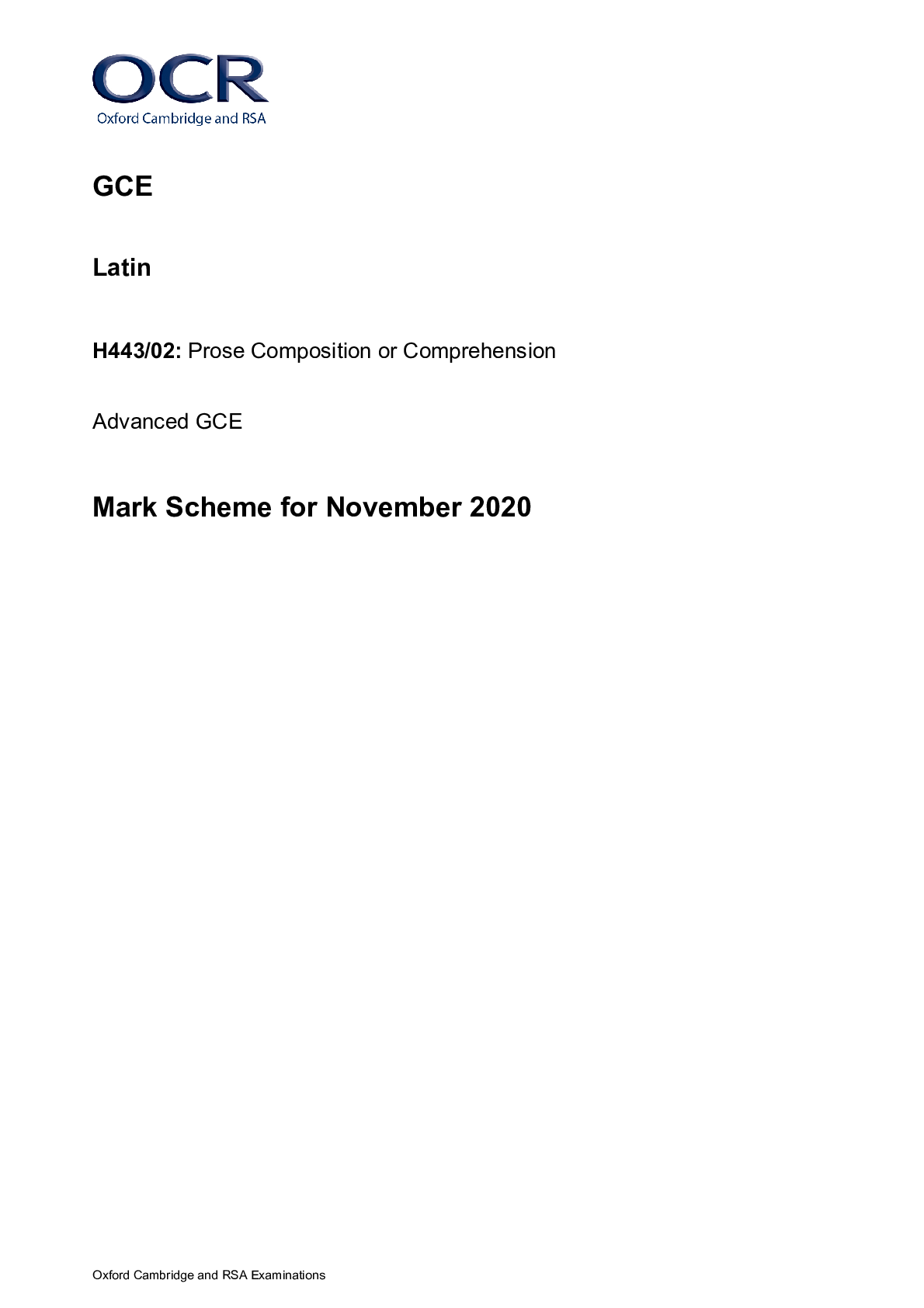Classical Civilisation > GCSE MARK SCHEME > GCSE (9–1) Classical Civilisation J199/23: War and warfare General Certificate of Secondary Educat (All)
GCSE (9–1) Classical Civilisation J199/23: War and warfare General Certificate of Secondary Education Mark Scheme for November 2020
Document Content and Description Below
GCSE (9–1) Classical Civilisation J199/23: War and warfare General Certificate of Secondary Education Mark Scheme for November 2020 Oxford Cambridge and RSA Examinations GCSE (9–1) Classical Ci... vilisation J199/23: War and warfare General Certificate of Secondary Education Mark Scheme for November 2020Oxford Cambridge and RSA Examinations OCR (Oxford Cambridge and RSA) is a leading UK awarding body, providing a wide range of qualifications to meet the needs of candidates of all ages and abilities. OCR qualifications include AS/A Levels, Diplomas, GCSEs, Cambridge Nationals, Cambridge Technicals, Functional Skills, Key Skills, Entry Level qualifications, NVQs and vocational qualifications in areas such as IT, business, languages, teaching/training, administration and secretarial skills. It is also responsible for developing new specifications to meet national requirements and the needs of students and teachers. OCR is a not-for-profit organisation; any surplus made is invested back into the establishment to help towards the development of qualifications and support, which keep pace with the changing needs of today’s society. This mark scheme is published as an aid to teachers and students, to indicate the requirements of the examination. It shows the basis on which marks were awarded by examiners. It does not indicate the details of the discussions which took place at an examiners’ meeting before marking commenced. All examiners are instructed that alternative correct answers and unexpected approaches in candidates’ scripts must be given marks that fairly reflect the relevant knowledge and skills demonstrated. Mark schemes should be read in conjunction with the published question papers and the report on the examination. © OCR 2020J199/23 Mark Scheme November 2020 2 Annotations Annotation Meaning Blank Page Seen Tick Questionable response Incorrect Unclear Omission Repetition Benefit Of Doubt Too Vague SpellingJ199/23 Mark Scheme November 2020 3 SUBJECT–SPECIFIC MARKING INSTRUCTIONS Introduction Your first task as an Examiner is to become thoroughly familiar with the material on which the examination depends. You should ensure that you have copies of these materials: • the specification, especially the assessment objectives • the question paper and its rubrics • the mark scheme. You should ensure also that you are familiar with the administrative procedures related to the marking process. These are set out in the OCR booklet Instructions for Examiners. If you are examining for the first time, please read carefully Appendix 5 Introduction to Script Marking: Notes for New Examiners. Please ask for help or guidance whenever you need it. Your first point of contact is your Team Leader. Using the Mark Scheme Please study this Mark Scheme carefully. The Mark Scheme is an integral part of the process that begins with the setting of the question paper and ends with the awarding of grades. Question papers and Mark Schemes are developed in association with each other so that issues of differentiation and positive achievement can be addressed from the very start. This Mark Scheme is a working document; it is not exhaustive; it does not provide ‘correct’ answers. The Mark Scheme can only provide ‘best guesses’ about how the question will work out, and it is subject to revision after we have looked at a wide range of scripts. The Examiners’ Standardisation Meeting will ensure that the Mark Scheme covers the range of candidates’ responses to the questions, and that all Examiners understand and apply the Mark Scheme in the same way. The Mark Scheme will be discussed and amended at the meeting, and administrative procedures will be confirmed. Co-ordination scripts will be issued at the meeting to exemplify aspects of candidates’ responses and achievements; the co-ordination scripts then become part of this Mark Scheme. Before the Standardisation Meeting, you should read and mark in pencil a number of scripts, in order to gain an impression of the range of responses and achievement that may be expected.J199/23 Mark Scheme November 2020 4 Question Indicative Content Marks (AO) Guidance Section A 1a Source A shows Athenian cavalrymen. In the Athenian military how was it decided whether someone would be a hoplite, a cavalryman or a rower? One from: • wealth (1) • social status (1) • if you could afford a horse (1) 1 (AO1) 1b Why was this? One from: • because you had to buy your own equipment (1) • rowers did not need to buy their equipment (1) 1 (AO1) 2 Describe the role of the legionary marked X. Make three points. Three from: • cornicen/horn player (1) • communicated orders (1) • keep the soldiers working together in battle (1) • maintain the morale of soldiers (1) 3 (AO1) 3 Identify one feature of the legionary marked Y and suggest what this tells us about how the Romans did battle. • standard bearer/signifer(1) • carried the colours into battle (1) • went into battle in centuries following the standard (1) • fought in formation (1) • the honour of the companies was important/comradeship (1) 1 (AO1) 1 (AO2) 4 a Source C shows a Spartan soldier. Identify two items of military equipment used by a Spartan warrior. Two from: 2 (AO1)J199/23 Mark Scheme November 2020 5 Question Indicative Content Marks (AO) Guidance • greaves(1) • shield (1) • breastplate (1) • helmet (1) • sword (1) • spear (1) 4b Choose one of these items of equipment and state why it was important to a Spartan warrior in battle. One from: • greaves protect shins (1) • shield protects half of the soldier and half of his comrade (1) • breastplate protects torso (1) • helmet protects head (1) • spear for stabbing enemies (1) • sword for wounding enemies (1) • shield used offensively (1) 1 (AO2) 4c What did Spartans call their slaves? • helots (1) 1 (AO1) 4d How might the slaves help the Spartans in battle? One from: • skirmishers (1) • baggage handlers (1) • the Spartans were great fighters because they had slaves to do all the other jobs while they did army training (1) 1 (AO1) 4e Why might the Spartan slaves be harmful to the Spartans? Two from: • outnumbered them (1) • might revolt (1) 2 (AO1)J199/23 Mark Scheme November 2020 6 Question Indicative Content Marks (AO) Guidance 5 Identify a piece of military equipment in Source D and describe how it was used. • ballista (1) • shot iron darts at the enemy with accuracy (1) • attack the enemy from a distance (1) • functioned like a cross bow (1) 1 (AO1) 1 (AO2) Credit references to any equipment shown in the sources with accurate description of its use. 6 Source E shows the battle of Actium. Identify three features of the Roman warships and suggest what each might tell us about how the Romans used their ships in battle. • banks of oars (AO1) o swift movement, maneuvering getting close to other ships to board (AO2) • battering rams (AO1) o crash into enemy ships to make them sink (AO2) • deck mounted towers to shoot from (AO1) o attack enemy ships with spears / arrows / board other ships to fight (AO2) • ships manned by legionary soldiers (AO1) o soldiers fight men on other ships with spears and swords (AO2) 3 (AO1) 3 (AO2) One mark is awarded for identification of a relevant feature (AO1), and one for suitable analysis of it (AO2). 7 Describe what happened at the Battle of Actium and why Octavian won. Use source E as a starting point and your own knowledge in your answer. AO1 • Octavian had 250 ships and commanded on the right and had Agrippa commanding on the left • Antony had 170 plus 60 Egyptian ones commanded by Cleopatra • Cleopatra’s ships were behind Antony’s; Antony was commanding on the right opposite Agrippa • Octavian made crescent formation • Agrippa took his ships north to try to outflank Antony • Cleopatra’s ships broke through the middle of Octavian’s line and kept 8 (See LoR) The indicative content is a description of possible content only; all legitimate answers and approaches must be credited appropriately.J199/23 Mark Scheme November 2020 7 sailing • Antony followed her with a few ships; the rest stayed to fight but lost AO2 • By moving his ships north, Agrippa weakened the centre leaving a gap through which Cleopatra’s ships charged, not staying to fight • Antony’s fleet was slower and more vulnerable to ramming • Antony ordered his fleet to disengage in the middle of the battle but most of them couldn’t so they were left fighting without a commander and knowing he and Cleopatra had deserted them • Antony and Cleopatra were carrying their treasure on their ships so maybe they never really planned to fight • Antony’s heavier ships would have been stronger for close quarter fighting, but they were undermanned, slower and more vulnerable to rammingJ199/23 Mark Scheme November 2020 8 Guidance on applying the marking grids for the 8-mark detailed response Two Assessment Objectives are being assessed in this question: AO1 (Demonstrate knowledge and understanding…) and AO2 (Analyse, interpret and evaluate…). The two Assessment Objectives are equally weighted, and both worth 4 marks. The weighting of assessment objectives remains consistent throughout the levels. Responses are credited for AO1 for the detail and accuracy of the knowledge of the sources, their context and interpretation. Responses are credited for AO2 for how well the question is addressed, selecting relevant evidence from the sources and the conclusions drawn. Examiners must use a best fit approach when applying the mark scheme. This means considering both the strengths and the weaknesses of a response, particularly if it is imbalanced in terms of the two assessment objectives, when deciding which level reflects the overall performance. AO1 and AO2 are closely interlinked. Typically responses demonstrate both knowledge and understanding and analysis and interpretation of that knowledge in reasonably equal measure. In this way, a total mark of 6 might reflect a balance of 3 (AO1) + 3 (AO2), for example. However, an overly-descriptive response may focus on details from the sources but not draw many valid conclusions; this would be considered AO1 heavy. Care should be taken when marking such answers, as the lack of AO2 skills should limit the level at which this work can be rewarded; it should not be possible to achieve a mark of 7 made up of 6 (AO1) + 1 (AO2). Examples of specific issues or common unbalanced approaches to the question will be identified when finalising the mark scheme in preparation for standardisation. Details about how to deal with this will be included in the Guidance column for the question. Level Mark Characteristics of Performance 4 7–8 • consistently accurate and detailed knowledge and understanding of classical sources, using both those given in assessment and own wider knowledge (AO1) shows very good understanding of the sources’ cultural contexts and possible interpretations • a well-argued response to the question which is supported by a range of well-selected evidence (AO2) includes critical analysis, interpretation and evaluation 3 5–6 • accurate knowledge and understanding of classical sources, using both those given in assessment and own wider knowledge (AO1) shows good understanding of the sources’ cultural contexts and/or possible interpretations • a focused response to the question which is supported by a range of evidence (AO2) includes relevant analysis, interpretation and evaluation 2 3–4 • sound, mostly accurate, knowledge and understanding of classical sources, using both those given in assessment and own wider knowledge (AO1) shows some understanding of the sources’ cultural contexts and/or possible interpretations • engages with the general topic of the question, and is supported by limited range of evidence (AO2) includes some analysis, interpretation and evaluation 1 1–2 • limited knowledge and understanding of classical sources; responses may only make use of the sources given in the assessment (AO1) shows limited understanding of the sources’ cultural contexts and/or possible interpretations • little attempt at a very basic explanation of the topic of the question, supported by a few references to evidence (AO2) includes isolated analysis, interpretation and evaluation 0 0 • No response or no response worthy of creditJ199/23 Mark Scheme November 2020 9 8 ‘The education and training of the soldiers in the Spartan army was what made it the best army in the ancient world.’ How far do you agree? Justify your response. AO1 • boys went to the Agoge at age 7 • mothers indoctrinated boys before they were 7 • taught survival skills from an early age • taught how to work as a team • weaklings would have died before they joined the army • used to living with comrades • Tyrtaios used to teach them honour AO2 • brainwashed soldiers were not thinking for themselves • numbers limited by killing off weaklings • Athenians were free men fighting for their own city and they had voted to go to war • Athenians might not all be fit like the Spartans; Romans had to be fit for all the marching etc. • Romans were professionals – paid a decent wage, often had a trade first 15 (See LoR page x) The indicative content is a description of possible content only; all legitimate answers and approaches must be credited appropriately.J199/23 Mark Scheme November 2020 10 Guidance on applying the marking grids for the 15-mark extended response Two Assessment Objectives are being assessed in this question: AO1 (Demonstrate knowledge and understanding…) and AO2 (Analyse, interpret and evaluate…). The two Assessment Objectives are not equally weighted, as AO1 is worth 5 marks, and AO2 10. The weighting of assessment objectives remains consistent throughout the levels. Responses are credited for AO1 for the detail and accuracy of the knowledge of the sources, their context and interpretation. Responses are credited for AO2 for how well the question is addressed, selecting relevant evidence from the sources and the conclusions drawn. Examiners must use a best fit approach when applying the mark scheme. This means considering both the strengths and the weaknesses of a response, particularly if it is imbalanced in terms of the two assessment objectives, when deciding which level reflects the overall performance. AO1 and AO2 are closely interlinked. Typically responses demonstrate both knowledge and understanding and analysis and interpretation of that knowledge in reasonably equal measure. In this way, a total mark of 11 might reflect a balance of 3 (AO1) + 8 (AO2), for example. However, an overly-descriptive response may focus on details from the sources but not draw many valid conclusions; this would be considered AO1 heavy. Care should be taken when marking such answers, as the lack of AO2 skills should limit the level at which this work can be rewarded; it should not be possible to achieve a mark of 10 made up of 7 (AO1) + 3 (AO2). Examples of specific issues or common unbalanced approaches to the question will be identified when finalising the mark scheme in preparation for standardisation. Details about how to deal with this will be included in the Guidance column for the question. Level Mark Characteristics of Performance 5 13 – 15 • very good, detailed and accurate knowledge and understanding of classical sources with detailed understanding of the sources’ cultural contexts and possible interpretations (AO1) • very good analysis and interpretation of a wide range of well-selected evidence (AO2) • coherent argument with a clear line of reasoning, successful evaluation of sources, and convincing conclusions (AO2) 4 10 – 12 • good, accurate knowledge and understanding of classical sources with clear understanding of the sources’ cultural contexts and possible interpretations (AO1) • good analysis and interpretation of a wide range of relevant evidence (AO2) • consistently well-structured argument, consistent evaluation of sources, and sound conclusions (AO2) 3 7 – 9 • reasonable, mostly accurate, knowledge and understanding of classical sources with reasonable understanding of the sources’ cultural contexts and/or possible interpretations (AO1) • reasonable analysis and interpretation of a range of relevant evidence (AO2) • argument is on the whole appropriately structured, reasonable evaluation of sources, and relevant conclusions (AO2) 2 4 – 6 • basic knowledge and understanding of classical sources, with basic understanding of the sources’ cultural contexts and/or possible interpretations (AO1) • basic analysis and interpretation of some relevant evidence (AO2) • argument has some structure, some evaluation of sources, and some credible conclusions (AO2) 1 1 – 3 • limited knowledge and understanding of classical sources with little understanding of the sources’ cultural contexts and/or possible interpretations (AO1) • limited analysis and interpretation of little relevant evidence (AO2) • some attempt at reasoning, isolated use of sources, and weak conclusions (AO2) 0 0 • no response or no response worthy of creditJ199/23 Mark Scheme November 2020 11 9 ‘The Greeks won the battle of Salamis because their ships were better.’ How far do you agree? Justify your response. AO1 • The Greek ships were mainly triremes with bronze plated prows for ramming • The Greek ships were lighter and more stable • the Greeks were outnumbered • The Persian ships were heavier • Themistocles tricked the Persians with a false message • Themistocles chose the location of the battle • Xerxes didn’t listen to Artemisia AO2 • Themistocles’ manipulation of the other Greek cities meant that the Greek allies pulled together to face the Persians • Themistocles’ choice of location for the battle negated any advantage the Persians had in numbers and type of ships • Themistocles’ false message trick meant that the battle took place at that time and location • narrow strait meant the Persian numbers did not help them; heavier ships might ram better under different circumstances • Persian ships turned sideways due to current and were easy to ram • the lighter Greek ships were more suitable for the shallow water • Artemisia sank one of her own ships as a tactic; if Xerxes had listened to Artemisia and the battle had been fought in open waters, the Greeks would not have had the advantages they did have • the Athenian navy was better trained and more familiar with manoeuvring their ships 15 (See LoR page 1x) The indicative content is a description of possible content only; all legitimate answers and approaches must be credited appropriately.J199/23 Mark Scheme November 2020 12 Guidance on applying the marking grids for the 15-mark extended response Two Assessment Objectives are being assessed in this question: AO1 (Demonstrate knowledge and understanding…) and AO2 (Analyse, interpret and evaluate…). The two Assessment Objectives are not equally weighted, as AO1 is worth 5 marks, and AO2 10. The weighting of assessment objectives remains consistent throughout the levels. Responses are credited for AO1 for the detail and accuracy of the knowledge of the sources, their context and interpretation. Responses are credited for AO2 for how well the question is addressed, selecting relevant evidence from the sources and the conclusions drawn. Examiners must use a best fit approach when applying the mark scheme. This means considering both the strengths and the weaknesses of a response, particularly if it is imbalanced in terms of the two assessment objectives, when deciding which level reflects the overall performance. AO1 and AO2 are closely interlinked. Typically responses demonstrate both knowledge and understanding and analysis and interpretation of that knowledge in reasonably equal measure. In this way, a total mark of 11 might reflect a balance of 3 (AO1) + 8 (AO2), for example. However, an overly-descriptive response may focus on details from the sources but not draw many valid conclusions; this would be considered AO1 heavy. Care should be taken when marking such answers, as the lack of AO2 skills should limit the level at which this work can be rewarded; it should not be possible to achieve a mark of 10 made up of 7 (AO1) + 3 (AO2). Examples of specific issues or common unbalanced approaches to the question will be identified when finalising the mark scheme in preparation for standardisation. Details about how to deal with this will be included in the Guidance column for the question. Level Mark Characteristics of Performance 5 13 – 15 • very good, detailed and accurate knowledge and understanding of classical sources with detailed understanding of the sources’ cultural contexts and possible interpretations (AO1) • very good analysis and interpretation of a wide range of well-selected evidence (AO2) • coherent argument with a clear line of reasoning, successful evaluation of sources, and convincing conclusions (AO2) 4 10 – 12 • good, accurate knowledge and understanding of classical sources with clear understanding of the sources’ cultural contexts and possible interpretations (AO1) • good analysis and interpretation of a wide range of relevant evidence (AO2) • consistently well-structured argument, consistent evaluation of sources, and sound conclusions (AO2) 3 7 – 9 • reasonable, mostly accurate, knowledge and understanding of classical sources with reasonable understanding of the sources’ cultural contexts and/or possible interpretations (AO1) • reasonable analysis and interpretation of a range of relevant evidence (AO2) • argument is on the whole appropriately structured, reasonable evaluation of sources, and relevant conclusions (AO2) 2 4 – 6 • basic knowledge and understanding of classical sources, with basic understanding of the sources’ cultural contexts and/or possible interpretations (AO1) • basic analysis and interpretation of some relevant evidence (AO2) • argument has some structure, some evaluation of sources, and some credible conclusions (AO2) 1 1 – 3 • limited knowledge and understanding of classical sources with little understanding of the sources’ cultural contexts and/or possible interpretations (AO1) • limited analysis and interpretation of little relevant evidence (AO2) • some attempt at reasoning, isolated use of sources, and weak conclusions (AO2)J199/23 Mark Scheme November 2020 13 0 0 • no response or no response worthy of creditJ199/23 Mark Scheme November 2020 14 Question Indicative Content Marks (AO) Guidance Section B 10a ‘Mighty Diomedes’ (line 1). What is the name of this feature of epic poetry? epithet 1 (AO1) 10b Who is Diomedes referring to when he says ‘them’ in lines 3 and 4? • Aeneas(1) • Pandaurus (1) 2 (AO1) 10c According to Sthenelus, why should Diomedes be worried about ‘them’? Sthenelus says they are strong beyond measure (1) The both have noble heritage (1) 1 (AO1) 10d Choose two quotations from the passage that show the importance of the horses. Two from: • best of all horses … (1) • … gift for Tros … (1) • stole the breed … (1) • leave our own fine horses here (1) 2 (AO1) 10e Why does Diomedes want the horses? To win great glory 1 (AO2) 11a What has Pandaurus already done to Diomedes? One from: • shot him/wounded him (with an arrow) (1) 1 (AO1) 11b 'Diomedes hurled his spear whose bronze blade Athene guided' (lines 7-8). How does Athene's action here affect Diomedes' status as a hero? Two from: 1 (AO1) 1J199/23 Mark Scheme November 2020 15 Question Indicative Content Marks (AO) Guidance • makes him seem more heroic (1) • as he has divine support (1) • elevates his status (1) • gives him kleos (1) (AO2) 11c How, by his style of writing, does Homer emphasise the shocking nature of Pandarus’ death? Make two points using Source G in your answer. • tongue sheared, teeth shattered, exiting … chin (AO1) o gory detail / vivid vocabulary / imagery (AO2) • Athene guided (AO1) o help from goddess to do something so violent (AO2) • swift … swerved/ shattering … shearing (AO1) o alliteration (AO2) • white teeth (AO1) o he is handsome before he is pierced through his face (AO2) 2 (AO1) 2 (AO2) One mark is awarded for identification of a relevant feature (AO1), and one for suitable analysis of it (AO2). 12 Give two ways in which Homer makes this passage vivid. Support your points with reference to the passage. Examples might include any two of: • lion simile (AO1) o compares him to a wild creature in a detailed manner (AO2) • minute detail of the deaths - nipple (AO1) o draws attention to the individual wounds (AO2) • victims named (AO1) o we see them as real people dying (AO2) • biography of Xanthus and Thoon (AO1) o see effect of death – heirless father mourning them (AO2) 2 (AO1) 2 (AO2) One mark is awarded for identification of a relevant feature (AO1), and one for suitable analysis of it (AO2).J199/23 Mark Scheme November 2020 16 13a Line 2 ‘bitter hardship’: give an example of the sort of hardship a soldier might have to face. One from: • killing people/horror of battle • watching comrades die • marching long distances • harsh conditions • shortage of supplies 1 (AO1) 13b Line 3 ‘fearsome with his lance’: how was a lance used? for stabbing at/jabbing enemies from a distance / knocking other horsemen off their horses 1 (AO1) 13c Line 4 ‘fierce Parthians’: where was Parthia? East of the Roman Empire / modern Iran 1 (AO1) 13d Line 5 ‘spending his life in the open’: why might Roman soldiers have been said to spend their lives in the open? One from: • they lived in tents • marched from place to place • battles and manual work were done outside • collected crops/hunted for food 1 (AO1)J199/23 Mark Scheme November 2020 17 14 Discuss how the writers glorify warfare. Use Sources H and I as a starting point, and your own knowledge in your answer. AO1 • soldiers compared to lions • warrior linked to goddess • links to romance • warriors can cause gory slaughter AO2 • image of brave, strong heroes like noble animals - superhuman • heroes have divine favour • the queen and princess know the hero is too strong for their men • shows the destruction the skilled fighter can cause 8 (See LoR) The indicative content is a description of possible content only; all legitimate answers and approaches must be credited appropriately.J199/23 Mark Scheme November 2020 18 Guidance on applying the marking grids for the 8-mark detailed response Two Assessment Objectives are being assessed in this question: AO1 (Demonstrate knowledge and understanding…) and AO2 (Analyse, interpret and evaluate…). The two Assessment Objectives are equally weighted, and both worth 4 marks. The weighting of assessment objectives remains consistent throughout the levels. Responses are credited for AO1 for the detail and accuracy of the knowledge of the sources, their context and interpretation. Responses are credited for AO2 for how well the question is addressed, selecting relevant evidence from the sources and the conclusions drawn. Examiners must use a best fit approach when applying the mark scheme. This means considering both the strengths and the weaknesses of a response, particularly if it is imbalanced in terms of the two assessment objectives, when deciding which level reflects the overall performance. AO1 and AO2 are closely interlinked. Typically responses demonstrate both knowledge and understanding and analysis and interpretation of that knowledge in reasonably equal measure. In this way, a total mark of 6 might reflect a balance of 3 (AO1) + 3 (AO2), for example. However, an overly-descriptive response may focus on details from the sources but not draw many valid conclusions; this would be considered AO1 heavy. Care should be taken when marking such answers, as the lack of AO2 skills should limit the level at which this work can be rewarded; it should not be possible to achieve a mark of 7 made up of 6 (AO1) + 1 (AO2). Examples of specific issues or common unbalanced approaches to the question will be identified when finalising the mark scheme in preparation for standardisation. Details about how to deal with this will be included in the Guidance column for the question. Level Mark Characteristics of Performance 4 7–8 • consistently accurate and detailed knowledge and understanding of classical sources, using both those given in assessment and own wider knowledge (AO1) shows very good understanding of the sources’ cultural contexts and possible interpretations • a well-argued response to the question which is supported by a range of well-selected evidence (AO2) includes critical analysis, interpretation and evaluation 3 5–6 • accurate knowledge and understanding of classical sources, using both those given in assessment and own wider knowledge (AO1) shows good understanding of the sources’ cultural contexts and/or possible interpretations • a focused response to the question which is supported by a range of evidence (AO2) includes relevant analysis, interpretation and evaluation 2 3–4 • sound, mostly accurate, knowledge and understanding of classical sources, using both those given in assessment and own wider knowledge (AO1) shows some understanding of the sources’ cultural contexts and/or possible interpretations • engages with the general topic of the question, and is supported by limited range of evidence (AO2) includes some analysis, interpretation and evaluation 1 1–2 • limited knowledge and understanding of classical sources; responses may only make use of the sources given in the assessment (AO1) shows limited understanding of the sources’ cultural contexts and/or possible interpretations • little attempt at a very basic explanation of the topic of the question, supported by a few references to evidence (AO2) includes isolated analysis, interpretation and evaluation 0 0 • No response or no response worthy of creditJ199/23 Mark Scheme November 2020 19 15 ‘Achilles is the perfect hero.’ How far do you agree with this assessment of Achilles? Justify your response. AO1 • ancient Greek heroic qualities may include: courage, fighting skill/strength, divine favour, noble heritage, desire for kleos • sulks in his tent when Briseis is taken • fights well against Hektor • has divine patronage • mistreats the dead body of Hektor • takes revenge for Patroklos’ death AO2 • different interpretations of heroic qualities be should also be credited • anger/sulking could be seen to make him unheroic but he did it because his kleos had been impugned • disrespectful of human customs by dragging the body and not allowing it to be buried but Achilles respects Priam as a suppliant and does the right thing in the end • Achilles fulfils his heroic mission to avenge the death of Patroklos • he learns from his anger – matures – could be seen as perfect development • his skill as a fighter makes him heroic (he is the Greeks’ best warrior) and divine help adds to his kleos rather than showing him as weak for need in help 15 (See LoR page x) The indicative content is a description of possible content only; all legitimate answers and approaches must be credited appropriately.J199/23 Mark Scheme November 2020 20 Guidance on applying the marking grids for the 15-mark extended response Two Assessment Objectives are being assessed in this question: AO1 (Demonstrate knowledge and understanding…) and AO2 (Analyse, interpret and evaluate…). The two Assessment Objectives are not equally weighted, as AO1 is worth 5 marks, and AO2 10. The weighting of assessment objectives remains consistent throughout the levels. Responses are credited for AO1 for the detail and accuracy of the knowledge of the sources, their context and interpretation. Responses are credited for AO2 for how well the question is addressed, selecting relevant evidence from the sources and the conclusions drawn. Examiners must use a best fit approach when applying the mark scheme. This means considering both the strengths and the weaknesses of a response, particularly if it is imbalanced in terms of the two assessment objectives, when deciding which level reflects the overall performance. AO1 and AO2 are closely interlinked. Typically responses demonstrate both knowledge and understanding and analysis and interpretation of that knowledge in reasonably equal measure. In this way, a total mark of 11 might reflect a balance of 3 (AO1) + 8 (AO2), for example. However, an overly-descriptive response may focus on details from the sources but not draw many valid conclusions; this would be considered AO1 heavy. Care should be taken when marking such answers, as the lack of AO2 skills should limit the level at which this work can be rewarded; it should not be possible to achieve a mark of 10 made up of 7 (AO1) + 3 (AO2). Examples of specific issues or common unbalanced approaches to the question will be identified when finalising the mark scheme in preparation for standardisation. Details about how to deal with this will be included in the Guidance column for the question. Level Mark Characteristics of Performance 5 13 – 15 • very good, detailed and accurate knowledge and understanding of classical sources with detailed understanding of the sources’ cultural contexts and possible interpretations (AO1) • very good analysis and interpretation of a wide range of well-selected evidence (AO2) • coherent argument with a clear line of reasoning, successful evaluation of sources, and convincing conclusions (AO2) 4 10 – 12 • good, accurate knowledge and understanding of classical sources with clear understanding of the sources’ cultural contexts and possible interpretations (AO1) • good analysis and interpretation of a wide range of relevant evidence (AO2) • consistently well-structured argument, consistent evaluation of sources, and sound conclusions (AO2) 3 7 – 9 • reasonable, mostly accurate, knowledge and understanding of classical sources with reasonable understanding of the sources’ cultural contexts and/or possible interpretations (AO1) • reasonable analysis and interpretation of a range of relevant evidence (AO2) • argument is on the whole appropriately structured, reasonable evaluation of sources, and relevant conclusions (AO2) 2 4 – 6 • basic knowledge and understanding of classical sources, with basic understanding of the sources’ cultural contexts and/or possible interpretations (AO1) • basic analysis and interpretation of some relevant evidence (AO2) • argument has some structure, some evaluation of sources, and some credible conclusions (AO2) 1 1 – 3 • limited knowledge and understanding of classical sources with little understanding of the sources’ cultural contexts and/or possible interpretations (AO1) • limited analysis and interpretation of little relevant evidence (AO2) • some attempt at reasoning, isolated use of sources, and weak conclusions (AO2) 0 0 • no response or no response worthy of creditJ199/23 Mark Scheme November 2020 21 16 How important are the gods in the texts you have studied? Justify your response and refer to at least two texts. AO1 • gods and goddesses as characters in epic • help/hinder humans • give status to heroes • live by different standards than humans AO2 • gods brought down to the level of humans in epic when we see their emotions etc. • divine origins/sponsorship of places/people • the audience believed in those gods • make more exciting things happen – supernatural • see things from different perspective 15 (See LoR page 1x) The indicative content is a description of possible content only; all legitimate answers and approaches must be credited appropriately.J199/23 Mark Scheme November 2020 22 Guidance on applying the marking grids for the 15-mark extended response Two Assessment Objectives are being assessed in this question: AO1 (Demonstrate knowledge and understanding…) and AO2 (Analyse, interpret and evaluate…). The two Assessment Objectives are not equally weighted, as AO1 is worth 5 marks, and AO2 10. The weighting of assessment objectives remains consistent throughout the levels. Responses are credited for AO1 for the detail and accuracy of the knowledge of the sources, their context and interpretation. Responses are credited for AO2 for how well the question is addressed, selecting relevant evidence from the sources and the conclusions drawn. Examiners must use a best fit approach when applying the mark scheme. This means considering both the strengths and the weaknesses of a response, particularly if it is imbalanced in terms of the two assessment objectives, when deciding which level reflects the overall performance. AO1 and AO2 are closely interlinked. Typically responses demonstrate both knowledge and understanding and analysis and interpretation of that knowledge in reasonably equal measure. In this way, a total mark of 11 might reflect a balance of 3 (AO1) + 8 (AO2), for example. However, an overly-descriptive response may focus on details from the sources but not draw many valid conclusions; this would be considered AO1 heavy. Care should be taken when marking such answers, as the lack of AO2 skills should limit the level at which this work can be rewarded; it should not be possible to achieve a mark of 10 made up of 7 (AO1) + 3 (AO2). Examples of specific issues or common unbalanced approaches to the question will be identified when finalising the mark scheme in preparation for standardisation. Details about how to deal with this will be included in the Guidance column for the question. Level Mark Characteristics of Performance 5 13 – 15 • very good, detailed and accurate knowledge and understanding of classical sources with detailed understanding of the sources’ cultural contexts and possible interpretations (AO1) • very good analysis and interpretation of a wide range of well-selected evidence (AO2) • coherent argument with a clear line of reasoning, successful evaluation of sources, and convincing conclusions (AO2) 4 10 – 12 • good, accurate knowledge and understanding of classical sources with clear understanding of the sources’ cultural contexts and possible interpretations (AO1) • good analysis and interpretation of a wide range of relevant evidence (AO2) • consistently well-structured argument, consistent evaluation of sources, and sound conclusions (AO2) 3 7 – 9 • reasonable, mostly accurate, knowledge and understanding of classical sources with reasonable understanding of the sources’ cultural contexts and/or possible interpretations (AO1) • reasonable analysis and interpretation of a range of relevant evidence (AO2) • argument is on the whole appropriately structured, reasonable evaluation of sources, and relevant conclusions (AO2) 2 4 – 6 • basic knowledge and understanding of classical sources, with basic understanding of the sources’ cultural contexts and/or possible interpretations (AO1) • basic analysis and interpretation of some relevant evidence (AO2) • argument has some structure, some evaluation of sources, and some credible conclusions (AO2) 1 1 – 3 • limited knowledge and understanding of classical sources with little understanding of the sources’ cultural contexts and/or possible interpretations (AO1) • limited analysis and interpretation of little relevant evidence (AO2)J199/23 Mark Scheme November 2020 23 • some attempt at reasoning, isolated use of sources, and weak conclusions (AO2) 0 0 • no response or no response worthy of creditOCR (Oxford Cambridge and RSA Examinations) The Triangle Building Shaftesbury Road Cambridge CB2 8EA OCR Customer Contact Centre Education and Learning Telephone: 01223 553998 Facsimile: 01223 552627 [Show More]
Last updated: 1 year ago
Preview 1 out of 25 pages

Buy this document to get the full access instantly
Instant Download Access after purchase
Add to cartInstant download
We Accept:

Reviews( 0 )
$6.50
Document information
Connected school, study & course
About the document
Uploaded On
Oct 07, 2022
Number of pages
25
Written in
Additional information
This document has been written for:
Uploaded
Oct 07, 2022
Downloads
0
Views
65

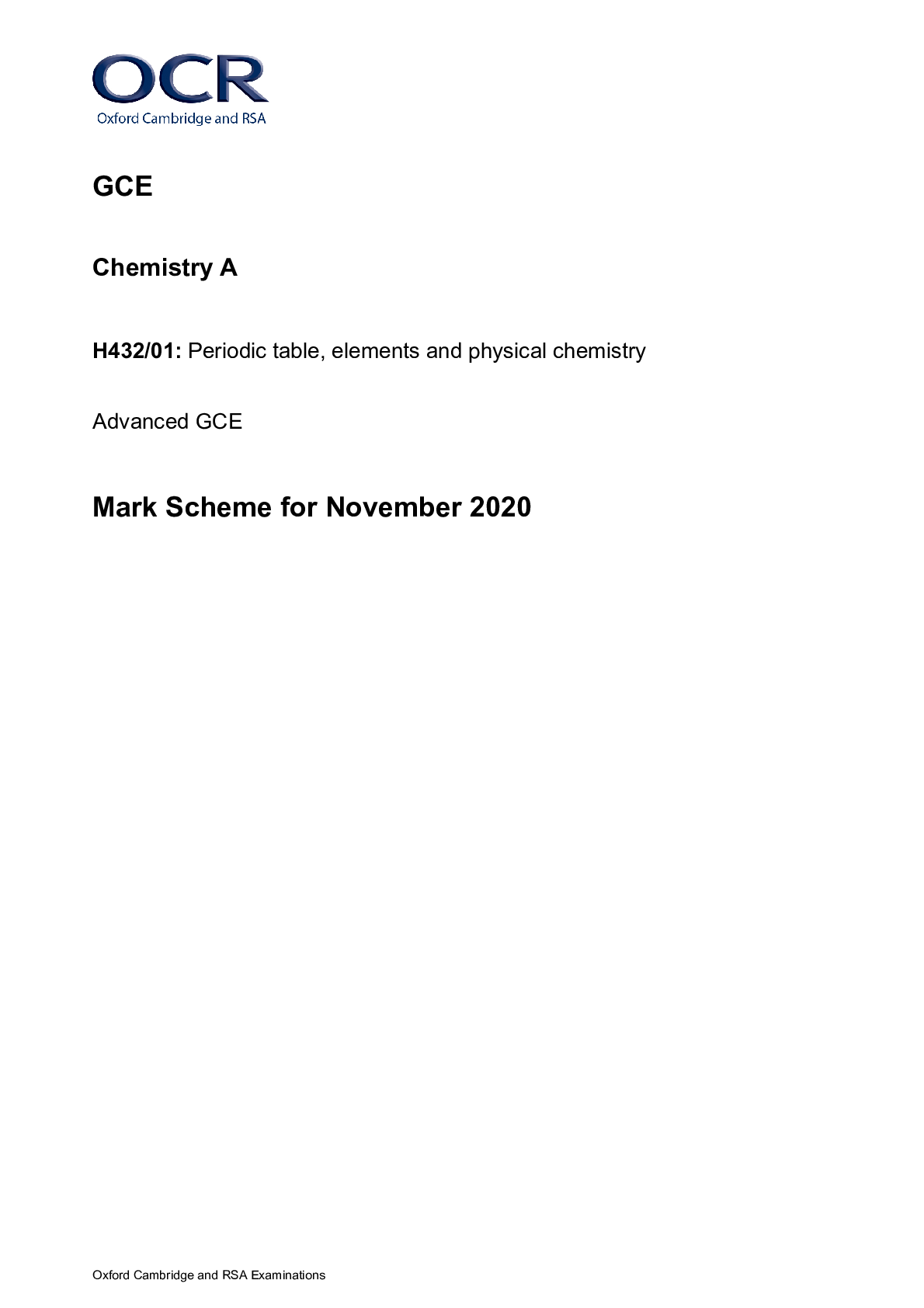

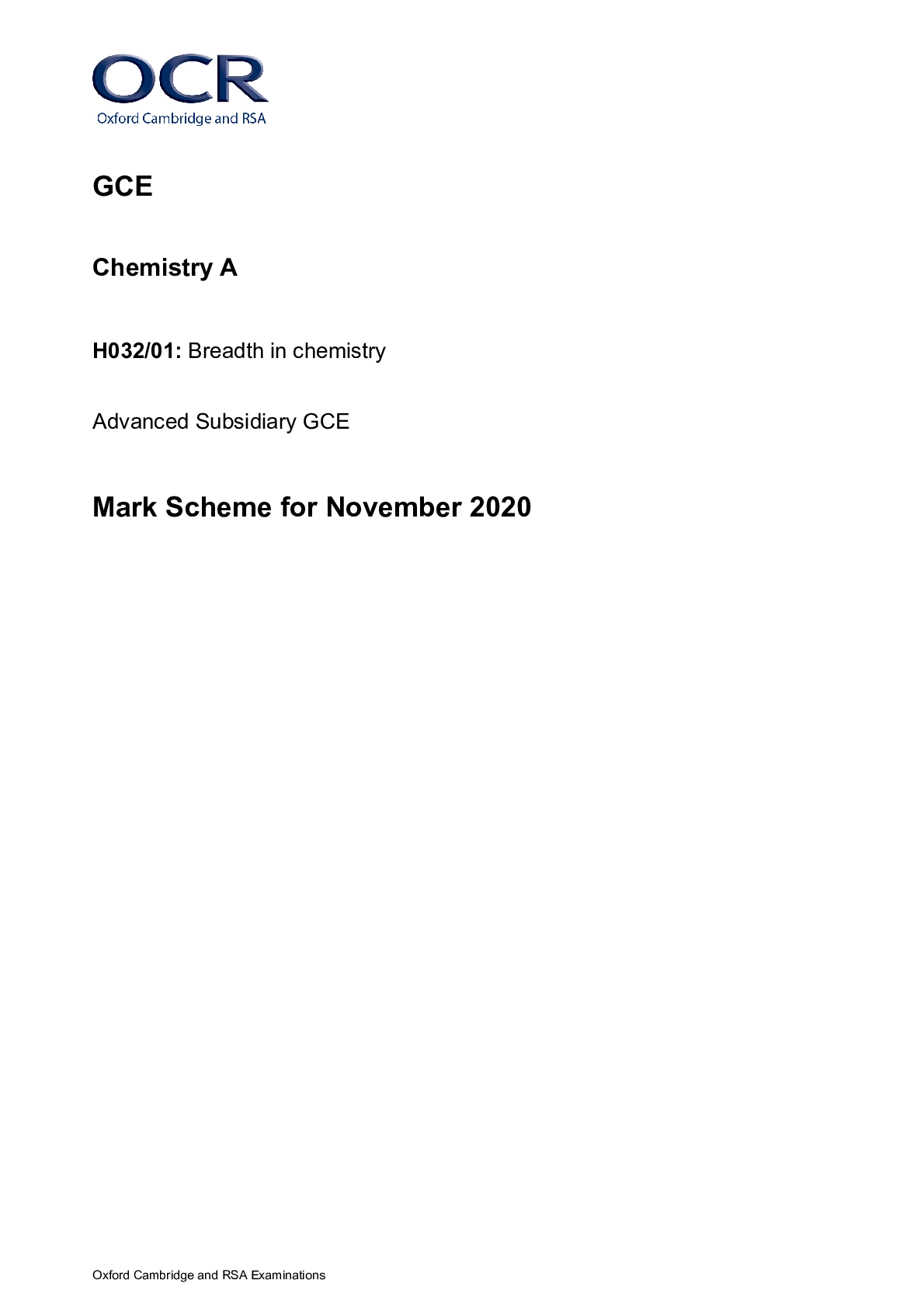


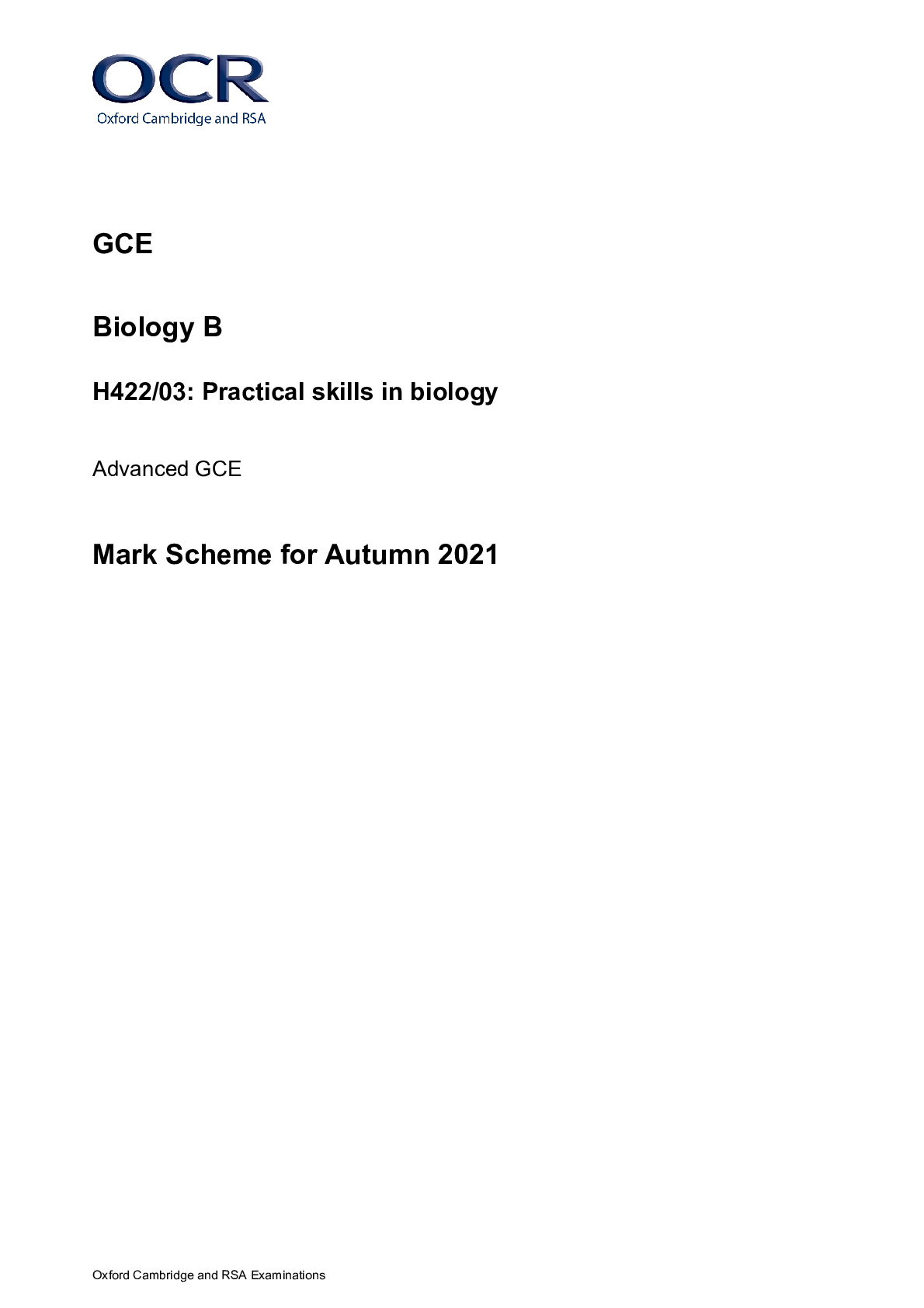

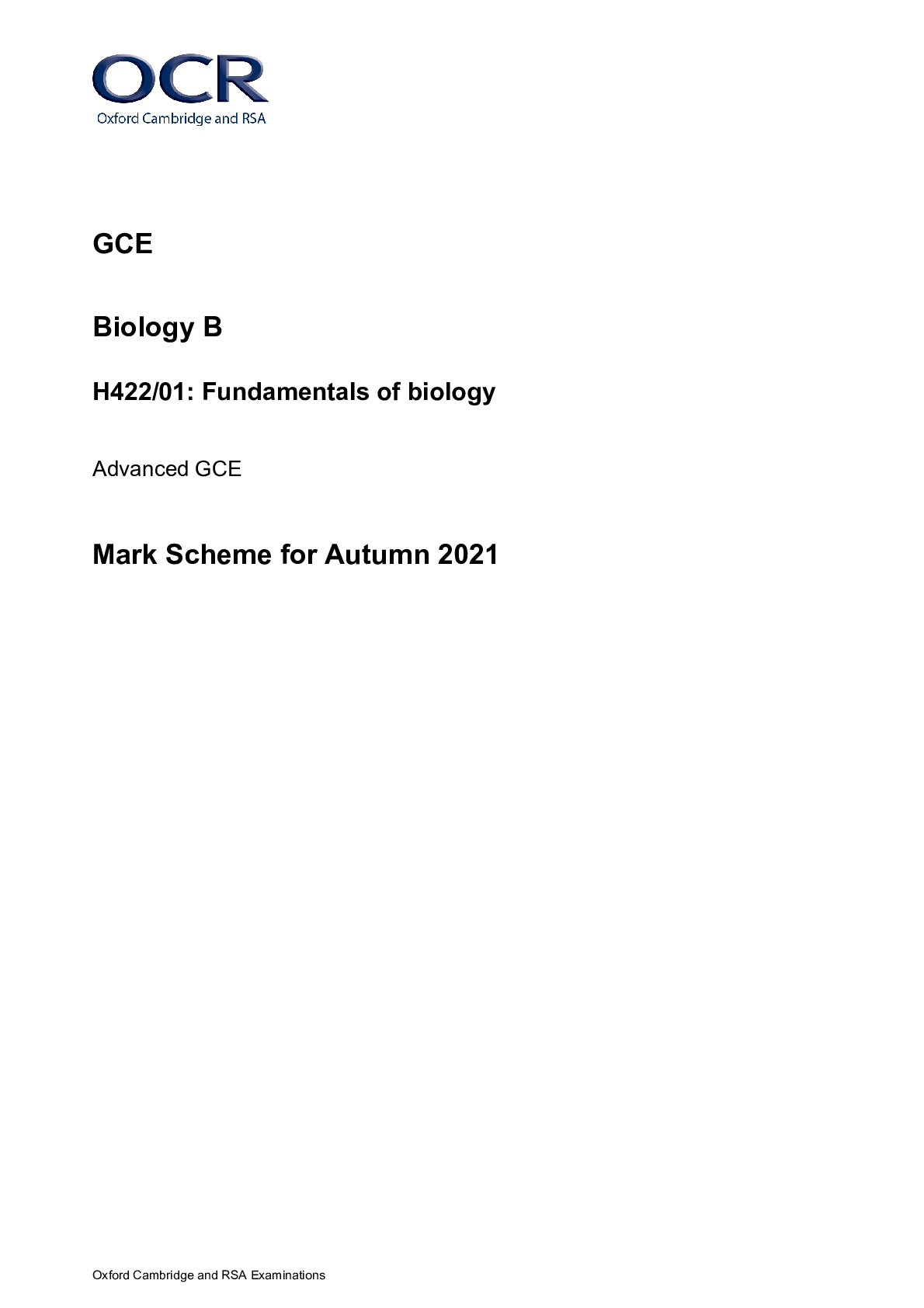
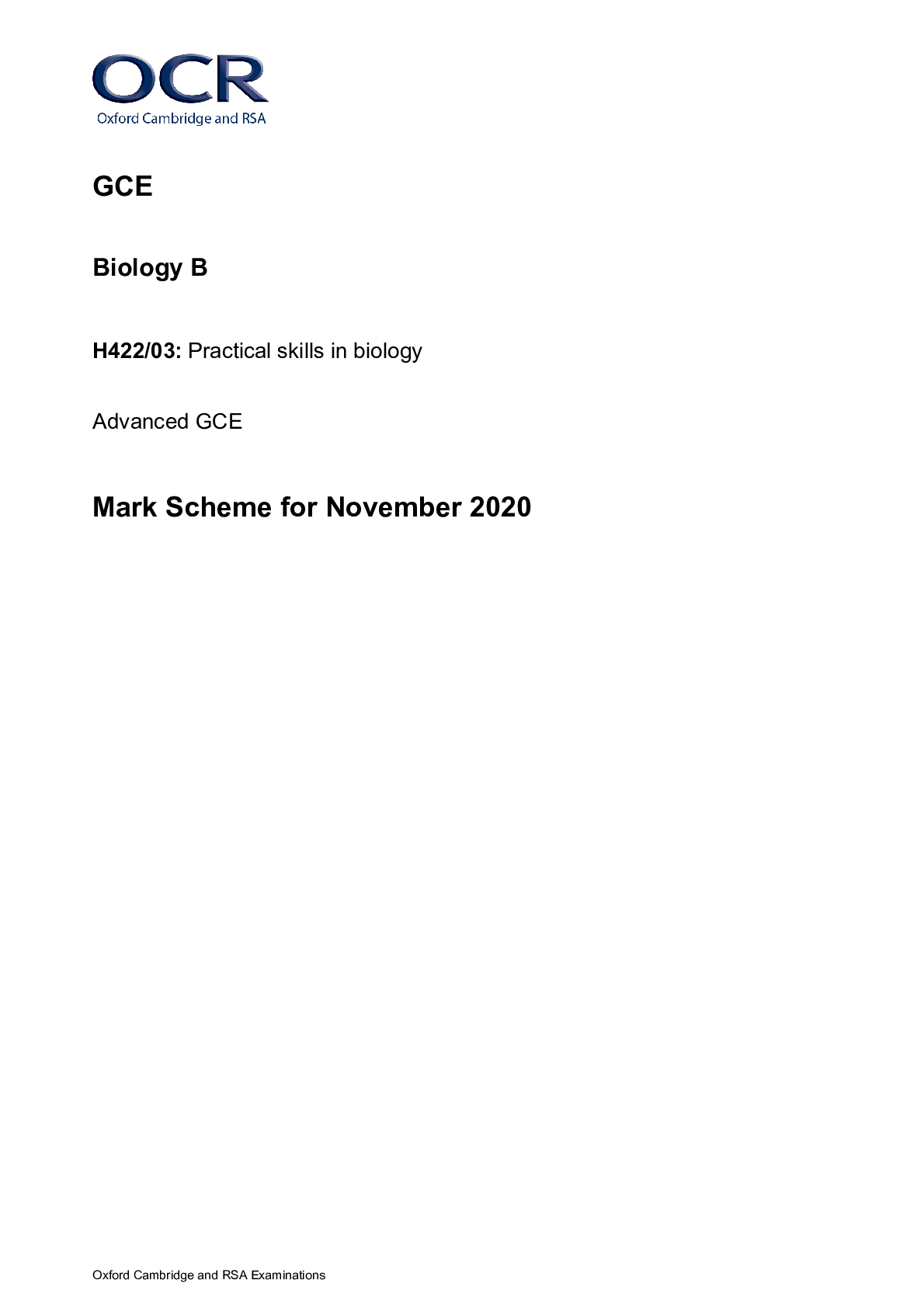
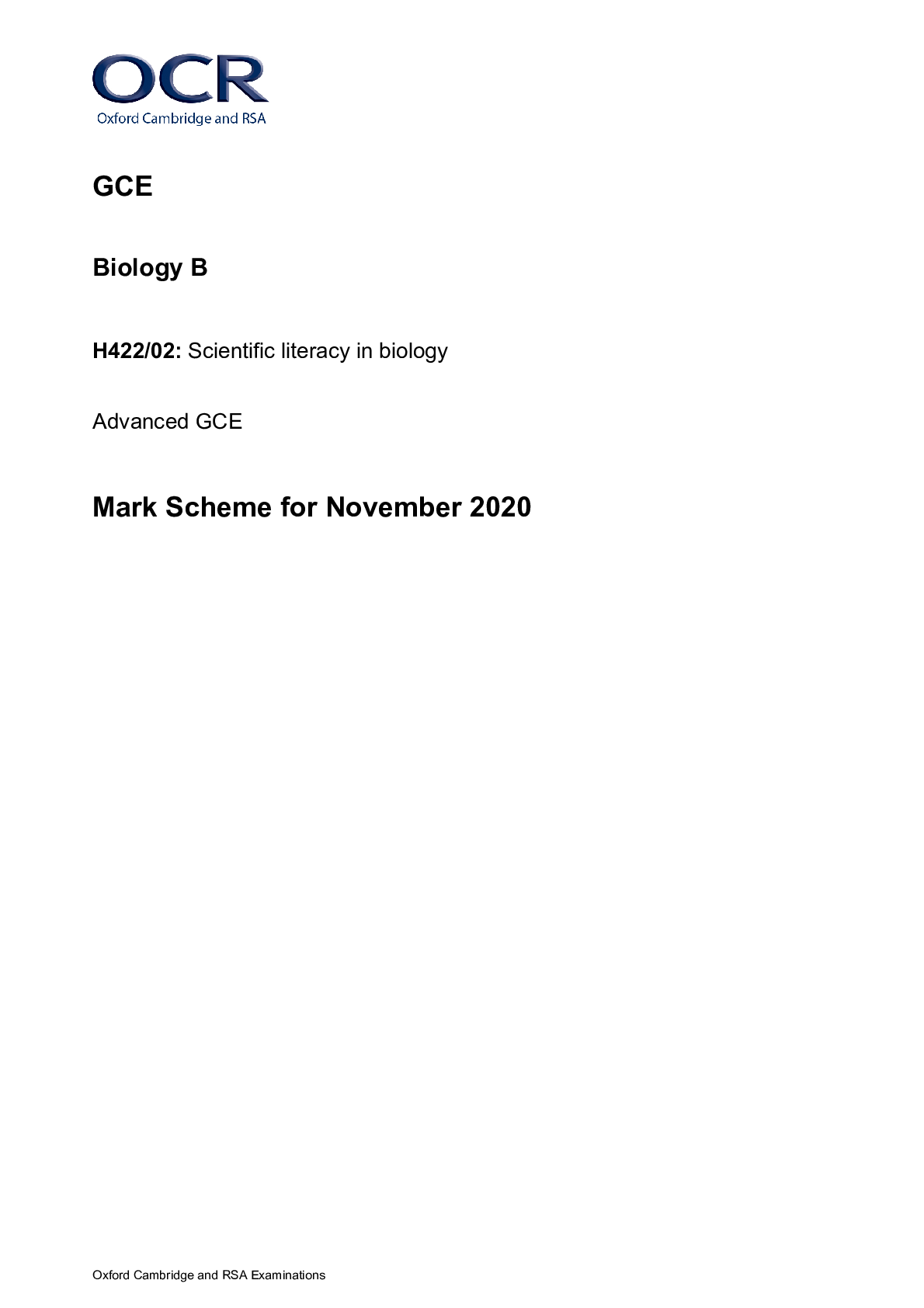
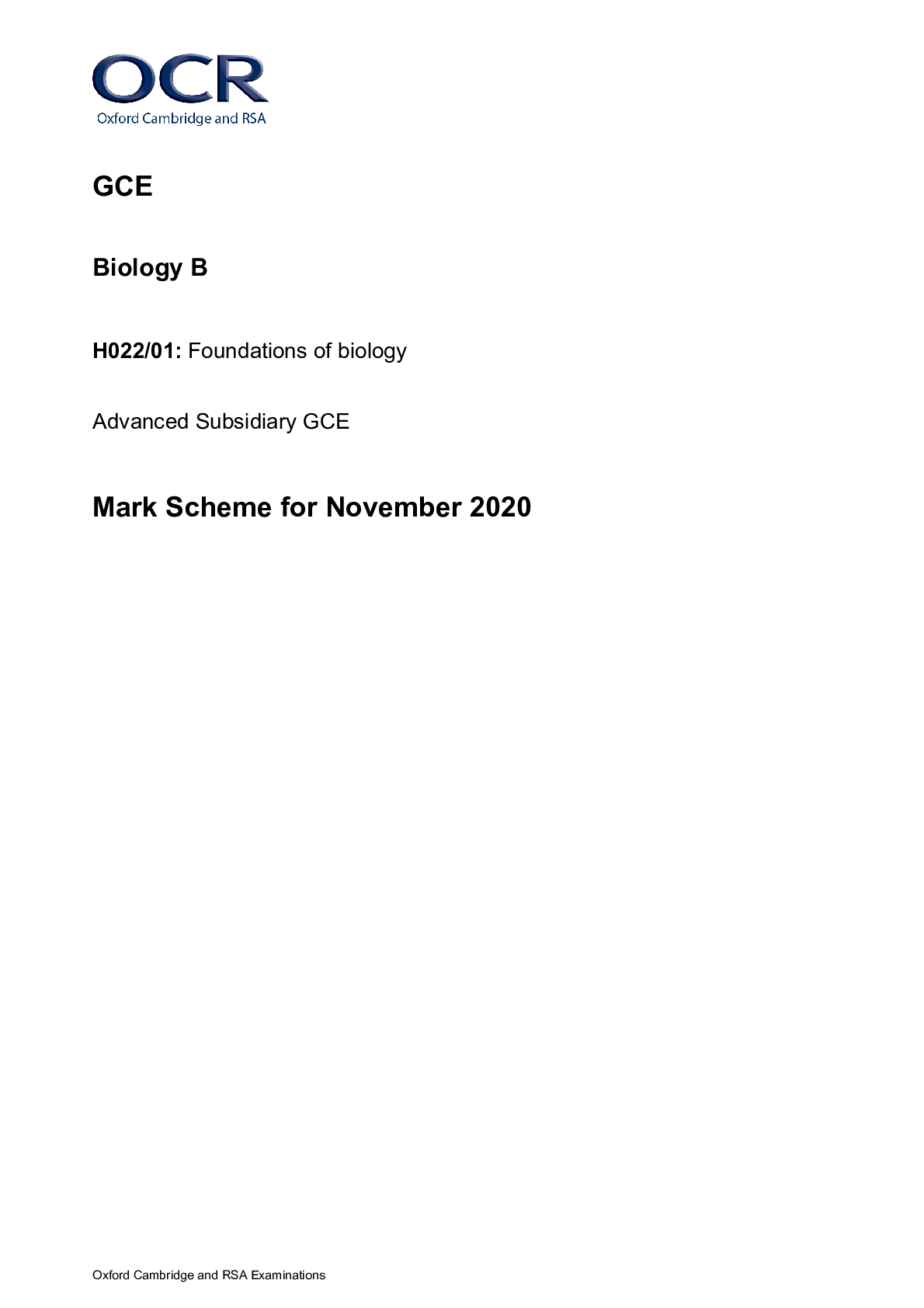



.png)
